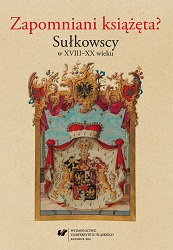Inwentaryzacja bielskiego zamku po śmierci księcia Aleksandra Józefa Sułkowskiego w 1804 roku
The stock of the Bielsko castle after the death of prince Aleksander Józef Sułkowski in 1804
Author(s): Grzegorz Madej
Subject(s): History
Published by: Wydawnictwo Uniwersytetu Śląskiego
Summary/Abstract: Over the course of centuries the Bielsko castle was subject to numerous transformations. The final considerable alterations of its form were introduced by the Sułkowski princes, who ruled the demesnes at the Biała River in the years 1752–1945. The first representative of the family who introduced significant architectural changes in the castle was Franciszek Sułkowski (1733–1812), the fourth Bielsko prince. Immediately after assuming the fidei commissum of Bielsko in 1786, the new owner set about extending his seat. A comparison of two stocks that were taken in 1786 and in 1804, respectively, presents the differences in the structure before and after modernisation. The first of these stocks was taken after the death of the princely brother, August (1729–1786), and the second one was taken after the death of Franciszek’s eldest son, Aleksander Józef (1775–1804), who at that time was the administrator of the family estate. The stock that was taken in 1804 constitutes a significant supplement to the knowledge about the princely castle that was gained until thattime. The castle was remodelled in the late 18th century, and its image until that time wasfamiliar to us only owing to the earliest panorama of Bielsko that was created by SamuelJohanny. According to the aforementioned document, prince Franciszek constructed a third floor in the eastern and northern wings, thus gaining a dozen or so new rooms. The document also confirms that at that time a great stand-alone castle chapel existed there. What is also important, the stock indicates that on the first floor of the Bielsko castle Franciszek established the principal section, known as the piano nobile. The eight rooms of this section featured parquet floors. It is most likely that the billiards room was the hub of the cultural life in the castle. Among the more interesting chambers one may distinguish also the following ones: the hairdresser’s room, the yellow room, the green room, the rock room and the Conservatorio. The latter held numerous objects, including the famous armorial service of the Sułkowski family that was created in the Meissen workshop in the years 1735–1738. The stock that was taken in 1804 presents the interior of the Bielsko castle that was set in the Classicistic manner that was de rigueur at that time, featuring green and grey hues that were fashionable at that time. We may merely conjecture that the interior was modelled after the pattern of Viennese palaces. In conclusion, one must assume that Sułkowski drew inspiration from the Danube capital of the Habsburgs, where he spent a great deal of his life with his family after 1786.
Book: Zapomniani książęta? Sułkowscy w XVIII–XX wieku
- Page Range: 69-87
- Page Count: 19
- Publication Year: 2016
- Language: Polish
- Content File-PDF

